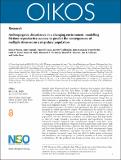Files in this item
Anthropogenic disturbance in a changing environment : modelling lifetime reproductive success to predict the consequences of multiple stressors on a migratory population
Item metadata
| dc.contributor.author | Pirotta, Enrico | |
| dc.contributor.author | Mangel, Marc | |
| dc.contributor.author | Costa, Daniel P. | |
| dc.contributor.author | Goldbogen, Jeremy | |
| dc.contributor.author | Harwood, John | |
| dc.contributor.author | Hin, Vincent | |
| dc.contributor.author | Irvine, Ladd M. | |
| dc.contributor.author | Mate, Bruce R. | |
| dc.contributor.author | McHuron, Elizabeth A. | |
| dc.contributor.author | Palacios, Daniel M. | |
| dc.contributor.author | Schwarz, Lisa K. | |
| dc.contributor.author | New, Leslie | |
| dc.date.accessioned | 2019-07-11T11:30:07Z | |
| dc.date.available | 2019-07-11T11:30:07Z | |
| dc.date.issued | 2019-09 | |
| dc.identifier | 259579933 | |
| dc.identifier | 2995e4b2-5e55-4e09-a35d-377b808eb4dc | |
| dc.identifier | 85066053192 | |
| dc.identifier | 000483708700011 | |
| dc.identifier.citation | Pirotta , E , Mangel , M , Costa , D P , Goldbogen , J , Harwood , J , Hin , V , Irvine , L M , Mate , B R , McHuron , E A , Palacios , D M , Schwarz , L K & New , L 2019 , ' Anthropogenic disturbance in a changing environment : modelling lifetime reproductive success to predict the consequences of multiple stressors on a migratory population ' , Oikos , vol. 128 , no. 9 , pp. 1340-1357 . https://doi.org/10.1111/oik.06146 | en |
| dc.identifier.issn | 0030-1299 | |
| dc.identifier.other | RIS: urn:46506486E162F083534E64DB9595FAB4 | |
| dc.identifier.uri | https://hdl.handle.net/10023/18081 | |
| dc.description | This study was supported by Office of Naval Research grant N00014‐16‐1‐2858: ‘PCoD+: Developing widely‐applicable models of the population consequences of disturbance’. DPC, MM, EAM and LKS were supported by the E&P Sound and Marine Life Joint Industry Project of the International Association of Oil and Gas Producers. JAG was supported by funding from the Young Investigator Program at the Office of Naval Research (award no. N00014‐16‐1‐2477). VH was funded by European Research Council Grant No. 322814 awarded to A.M. de Roos. | en |
| dc.description.abstract | Animals make behavioural and reproductive decisions that maximise their lifetime reproductive success, and thus their fitness, in light of periodic and stochastic variability of the environment. Modelling the variation of an individual's energy levels formalises this tradeoff and helps to quantify the population‐level consequences of stressors (e.g. disturbance from human activities and environmental change) that can affect behaviour or physiology. In this study, we develop a dynamic state variable model for the spatially explicit behaviour, physiology and reproduction of a female, long‐lived, migratory marine vertebrate. The model can be used to investigate the spatio‐temporal patterns of behaviour and reproduction that allow an individual to maximise its overall reproductive output. We parametrised the model for eastern North Pacific blue whales Balaenoptera musculus, and used it to predict the effects of changing environmental conditions and increasing human disturbance on the population's vital rates. In baseline conditions, the model output had high fidelity to observed energy dynamics, movement patterns and reproductive strategies. Simulated scenarios suggested that environmental changes could have severe consequences on the population's vital rates, but that individuals could tolerate high levels of anthropogenic disturbance. However, this ability depended on where, when and how often disturbance occurred. In scenarios with both environmental change and anthropogenic disturbance, synergistic interactions caused stronger effects than in isolation. In general, larger body size offered a buffer against stochasticity and disturbance, and, consequently, we predicted juveniles to be more susceptible to disturbance. We also predicted that females prioritise their own survival at the expense of the current reproductive attempt, presumably the result of their long lifespan. Our approach provides a general framework to make predictions of the cumulative and synergistic effects of human disturbance and climate change on migratory populations, which can inform effective management and conservation efforts. | |
| dc.format.extent | 18 | |
| dc.format.extent | 3845675 | |
| dc.language.iso | eng | |
| dc.relation.ispartof | Oikos | en |
| dc.subject | Climate change | en |
| dc.subject | Dynamic state variable modelling | en |
| dc.subject | Marine mammals | en |
| dc.subject | Population consequences of disturbance | en |
| dc.subject | Synergistic effects | en |
| dc.subject | Vital rates | en |
| dc.subject | GE Environmental Sciences | en |
| dc.subject | QH301 Biology | en |
| dc.subject | NDAS | en |
| dc.subject | SDG 13 - Climate Action | en |
| dc.subject | SDG 14 - Life Below Water | en |
| dc.subject.lcc | GE | en |
| dc.subject.lcc | QH301 | en |
| dc.title | Anthropogenic disturbance in a changing environment : modelling lifetime reproductive success to predict the consequences of multiple stressors on a migratory population | en |
| dc.type | Journal article | en |
| dc.contributor.institution | University of St Andrews. School of Biology | en |
| dc.contributor.institution | University of St Andrews. Scottish Oceans Institute | en |
| dc.contributor.institution | University of St Andrews. St Andrews Sustainability Institute | en |
| dc.contributor.institution | University of St Andrews. Centre for Research into Ecological & Environmental Modelling | en |
| dc.identifier.doi | https://doi.org/10.1111/oik.06146 | |
| dc.description.status | Peer reviewed | en |
This item appears in the following Collection(s)
Items in the St Andrews Research Repository are protected by copyright, with all rights reserved, unless otherwise indicated.

